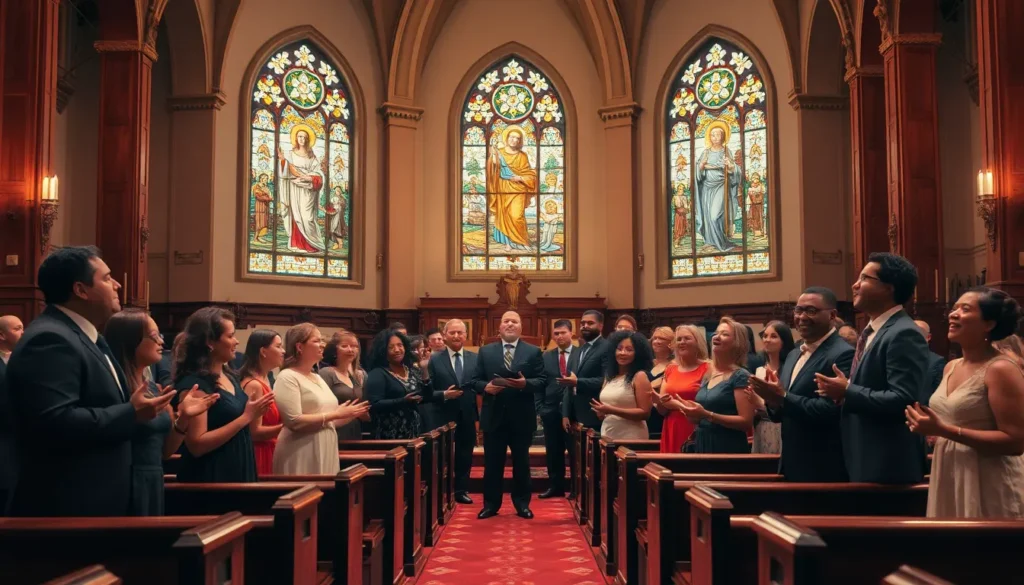Table of Contents
ToggleEver heard the phrase “in excelsis Deo” and wondered if it’s a secret password to a heavenly club? Spoiler alert: it’s not. This Latin term translates to “in the highest [heavens] to God,” and it’s packed with centuries of meaning. From Christmas carols to classical compositions, this phrase pops up more often than a cat meme on the internet.
Understanding In Excelsis Deo
The phrase “in excelsis Deo” holds deep historical importance. Its roots trace back to Latin, where it translates directly to “in the highest [heavens] to God.”
Definition and Origin
“In excelsis Deo” signifies divine exaltation. This expression often appears in liturgical contexts, particularly praising God’s sovereignty. Latin scholars identify its use in various ancient texts, emphasizing its role in religious traditions. Originating from the Christian hymn “Gloria in Excelsis Deo,” this phrase is used during the Eucharist, solidifying its connection to worship. Understanding this phrase involves recognizing its Latin components, with “excelsis” meaning “highest” and “Deo” referring to “God.”
Context in Religious Texts
Within religious texts, “in excelsis Deo” features prominently in Christian doctrine. The phrase conveys messages of praise and worship in biblical references. The Gospel of Luke includes it in the Angels’ proclamation to the shepherds, celebrating the birth of Christ. This declaration of glory emphasizes God’s grandeur and dominion over creation. Congregations around the world incorporate it into worship services and hymns, underscoring its enduring significance in Christianity.
In Excelsis Deo in Modern Usage

The phrase “in excelsis Deo” continues to resonate in contemporary culture. Its presence spans popular music and various artistic expressions, marking its impact on modern society.
Popular Songs and Hymns
Musicians incorporate “in excelsis Deo” into many popular songs and hymns. For example, the beloved Christmas carol “Angels We Have Heard on High” prominently features the phrase, celebrating the momentous announcement of Christ’s birth. Contemporary Christian artists also weave the expression into their lyrics, connecting modern worship with centuries of tradition. This enduring usage facilitates a sense of continuity across generations, allowing congregations and individuals to engage deeply with their faith.
Cultural References
Cultural references to “in excelsis Deo” appear in literature, film, and art. Numerous authors use the phrase to emphasize themes of divinity and exaltation within their works. Movies set during the Christmas season often include the phrase in dialogue, reinforcing the holiday’s spiritual significance. Visual artists sometimes depict the phrase in paintings and murals that celebrate the heavenly realm, adding to its rich tapestry of cultural importance. These references ensure the phrase remains a relevant symbol of divine praise in various contexts.
The Significance of In Excelsis Deo
The phrase “in excelsis Deo” carries profound meaning in both historical and contemporary contexts. Its impact resonates through centuries of tradition and modern expression.
Historical Importance
Latin origins underpin “in excelsis Deo,” making it a foundational phrase in Christian liturgy. The hymn “Gloria in Excelsis Deo” exemplifies its early usage during the Eucharist. Biblical context adds further significance, as seen in the Gospel of Luke, where angels proclaim the phrase to shepherds celebrating Christ’s birth. This declaration symbolizes God’s magnificence and sovereignty, establishing its importance in worship. Congregations around the world embraced the phrase, incorporating it into hymns and liturgical practices. Overall, its historical roots highlight its role in expressing divine glory and praise.
Contemporary Relevance
Modern society continues to embrace “in excelsis Deo” across various artistic expressions. Popular music, especially Christmas carols like “Angels We Have Heard on High,” features the phrase prominently, celebrating the birth of Jesus. Contemporary Christian artists also integrate it into new worship songs, bridging the gap between tradition and current faith practices. Literature and film often reference “in excelsis Deo” to highlight themes of divinity and exaltation. Visual artists create striking works that feature the phrase, ensuring its relevance endures in cultural conversations. Overall, “in excelsis Deo” remains a vibrant symbol of divine celebration today.
The phrase “in excelsis Deo” remains a powerful expression of divine praise that transcends time and culture. Its roots in Christian tradition provide a rich backdrop for its continued relevance in modern worship and artistic expression. From classical hymns to contemporary music and visual art, the phrase serves as a reminder of God’s grandeur and sovereignty. As it continues to inspire and resonate with audiences today, “in excelsis Deo” stands as a testament to the enduring nature of faith and the celebration of the divine across generations.




